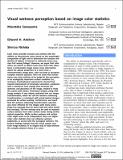Visual wetness perception based on image color statistics
Author(s)
Sawayama, Masataka; Nishida, Shin'ya; Adelson, Edward H
Downloadi1534-7362-17-5-7.pdf (2.313Mb)
PUBLISHER_CC
Publisher with Creative Commons License
Creative Commons Attribution
Terms of use
Metadata
Show full item recordAbstract
Color vision provides humans and animals with the abilities to discriminate colors based on the wavelength composition of light and to determine the location and identity of objects of interest in cluttered scenes (e.g., ripe fruit among foliage). However, we argue that color vision can inform us about much more than color alone. Since a trichromatic image carries more information about the optical properties of a scene than a monochromatic image does, color can help us recognize complex material qualities. Here we show that human vision uses color statistics of an image for the perception of an ecologically important surface condition (i.e., wetness). Psychophysical experiments showed that overall enhancement of chromatic saturation, combined with a luminance tone change that increases the darkness and glossiness of the image, tended to make dry scenes look wetter. Theoretical analysis along with image analysis of real objects indicated that our image transformation, which we call the wetness enhancing transformation, is consistent with actual optical changes produced by surface wetting. Furthermore, we found that the wetness enhancing transformation operator was more effective for the images with many colors (large hue entropy) than for those with few colors (small hue entropy). The hue entropy may be used to separate surface wetness from other surface states having similar optical properties. While surface wetness and surface color might seem to be independent, there are higher order color statistics that can influence wetness judgments, in accord with the ecological statistics. The present findings indicate that the visual system uses color image statistics in an elegant way to help estimate the complex physical status of a scene.
Date issued
2017-06Department
Massachusetts Institute of Technology. Computer Science and Artificial Intelligence LaboratoryJournal
Journal of Vision
Publisher
Association for Research in Vision and Opthalmology
Citation
Sawayama, Masataka, Edward H. Adelson, and Shin’ya Nishida. “Visual Wetness Perception Based on Image Color Statistics.” Journal of Vision 17, 5 (June 2017): 7 © 2017 The Authors
Version: Final published version
ISSN
1534-7362